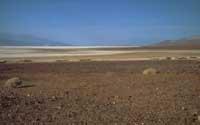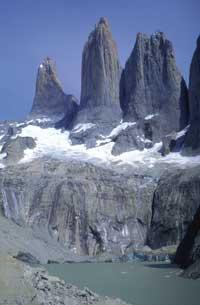World's deepest land fauna
2002/05/01 Elosegi Irurtia, Migel M. | Imaz Amiano, Eneko - Elhuyar Zientziaren Komunikazioa Iturria: Elhuyar aldizkaria
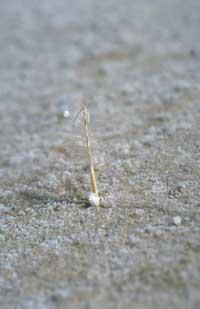
The anecdote of inbound cyclists is just one example of the extreme conditions that can be found in the depths of the world. The depressions are warm and dry areas that are below sea level and the Pangea expedition is born with the aim of studying these unique areas. The fauna found in the depressions of America and Australia is summarized below.
Death Valley Animals
Death Valley is the deepest area in North America (-86 m) and lies southeast of California. In the current territory of 13.500 km 2, national park, spectacular slopes are observed from the highest peaks of the Sierra de Panamint (3.367 m) to the lower part of the depression. Here, in the depression of the Death Valley, there is an annual rainfall of about 45 mm (in the driest places of the Basque Country about 300 mm) and an average temperature of July of about 49 ° C... in the shadows! It is the place with the highest average summer temperature in the world. Therefore, it does not seem to require a special space for animals. However, many animals live in the Death Valley, but to observe them it is appropriate to adapt them to their rhythm.
To avoid hours of sunshine, most of them are hidden throughout the day in shade or underground, appearing as the night comes and refreshes. It is usually a great surprise to find in the sand a lot of remains of beasts raised in the morning and andado at night, where no life is seen during the day.
Perhaps the most visible lizard species are different, they feed on ants, beetles, etc. of the area. One of the best-known reptiles is snakes. Among them are the chestnut snakes, which adapt perfectly to deserts.
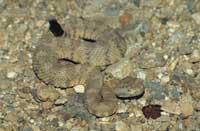
Mammals include kangaroo rats, donkeys and coyotes. The latter have adapted in most of North America, as in the Alaska tundra, in the Death Valley depression. Somehow, they are something between wolves and foxes and, like their relatives, they have an enormous capacity to exploit the resources offered by each place. Gregarians communicate through long villas and are common on death valley nights. As in cartoons, in the territories of the coyote lives the 'korrekamino' or corridor of roads. This eccentric bird lives in the deserts and is dedicated to touring all its extent asking for hunting. However, the most visible bird in the park is the rodete or hawk, which as a fast bird knows how to approach the areas through which tourists circulate in search of food remains.
The least you can expect from the desert is to see fish. In the Death Valley, however, there are several salty and hot water wells in which up to 5 species of fish and some amphibian have been found.
As in most of the world, people also managed to live in the Death Valley. The Indians of the Shoshone tribe have always lived around, collecting their seeds and practicing hunting.
Fauna of Lake Eyre
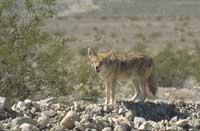
Lake Eyre is very special. In fact, the 'lake', which collects the waters of a territory of 1,200,000 km 2, is usually dry. Many Australian rivers, instead of heading to the coast, head towards the Eyre depression (-16 m), in the center of the continent, where they pour water. But the heat of this desert makes the waters evaporate along the way and evaporate in the 20th century. throughout the century only four have been flooded. The year 2000 was one of them.
In the desert the water is intense and must be used. When it rains a lot, a lake the size of Eyren Nafarroa is formed and, as a miracle, the entire ecosystem is launched. As the lake fills with water, for years the territory covered with salt and sand changes radically. From the wells that have been kept upstream come plankton, numerous invertebrates and fish. For their part, the seeds of various plants or the eggs of some animals have been buried for years, waiting for water. In this way, Eyre will be filled with amphibians, fish, etc., after which they will approach pelicans, cormorants, gulls, herons… to feed and reproduce.
But the lake will not last long. As the lake water evaporates, the salt concentration will increase and the living beings of the water will die. That is precisely what we find when we come to him: We find thousands of fish in the salt of the species Nematolosa erebi and Craterocephalus eresii.
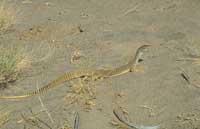
As in Death Valley, Ey's animals also avoid the hottest hours. There are exceptions. Flies and mosquitoes do not stop all day long and sometimes get really heavy.
Around the funnel are the water tanks prepared for livestock, to which asparagus, herons, ducks, heather, pigeons, hooks, etc. Apart from the aquatic environment, emu is common in the Australian desert. It is a bird similar to the ostrich that does not fly and whose young are taken care of by the males.
The best known mammals of the Australian desert, red kangaroos, can pass without drops if green plants are consumed; many rodents also get water from vomiting seeds. Many reptiles, birds and invertebrates also manage to pass with very little water. The spectacular sand dragon that inhabits around Lake Eyre, like Varanus gouldii, is perfectly adapted to this area. It is hidden in the underground holes and also makes a very concentrated urine to save water.
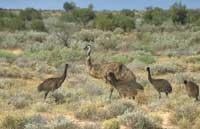
In Australia, however, we must also mention non-native animals that have been introduced abroad, such as camels, cows, rabbits, cats, etc. One can speak long and tense of each of them. Rabbits, for example, were taken by English to hunt and, as we could see around Eyre, can become pests. And because they don't have just enemies in Australia, their populations grow up without measures to endanger their wildlife. We could say the same thing as cats. Today they are the biggest enemies of native animals in Australia, and it is impossible for managers to control wild cats.
As for the people, it must be said that the aborigines were handled very well in the desert. Despite the absence of agriculture or livestock, they lived from hunting and collecting plants, but today, in general, they are in a lamentable situation. Since the whites arrived, the lands lost, they could not maintain traditional life or adapt to modern life.
Coal Friend
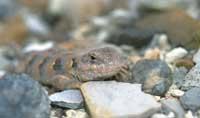
The Carbon Lagoon (-105 m), the deepest area in South America, being a depression, has similarities with the previous two. It is also a dry spot, with just 150 200 mm of rain per year. However, unlike them, it cannot be said that it is a hot medium. In summer they rarely exceed 30ºC and the average of the maximum temperatures in January is 12-13ºC.
As for wildlife, native animals need to cope with drought. The easiest thing to see is the guana. This camelid, the largest herbivore in Argentina, adapts very well to harsh conditions and can stay for months without drinking any water.

It also adapts to salt water and has sometimes been seen drinking sea water. It was striking to see how snail closures were overcome with a single jump. Its main natural enemies are the pumas. These were more abundant before before the arrival of the white man, but when grazing prevailed throughout Patagonia they were greatly reduced. In recent years it seems that the population has increased again due to the disappearance or decrease of grazing in several regions. We did not see any puma.
The villagers of the area used the hunted guaneses entirely: leather, meat, tendons, bones, all of which were used.
These three inhabitants had works from the appearance of the white man, to the practically totality of the culture of the tehuelches.
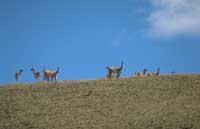
We have already mentioned salt water, both the Laguna del Carbón and most of the lakes of Patagonia are brackish or brackish (abundant although scarce rains) and it is relatively easy to see southern flamingos ( Phoenicopterus chilensis) eating aquatic invertebrates, especially reddish crustaceans (the waters of some lakes are pink). It is spectacular that the color point that flamingos put in a generally daring environment is flying.
Finally, among the fauna apparently richer than it seems, highlights a reptile called matuasto ( Diplolaemus darwini). It is difficult to imagine what the lizard does in a relatively cold place in most months of the year, since they are usually cold blood. But the blood of this species has a special composition, so that winter is also easily overcome.
Friend of Coal?
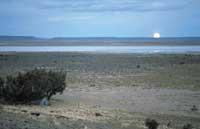
But… wasn’t there the lowest point in South America on the Valdés Peninsula? Salina Grande ( 48 m)? No! This misinformation appears in numerous known maps and atlases, as well as those of National Geography. In Argentina they are not very clear either. In fact, in the book 'La Patagonia sobre el mar; Península Valdés y Punta Tombo', published by Ediciones Larivière in 2000, the author points out: "…it is the lowest point in South America; only the Death Valley and the California Dead Sea (USA) are the lowest in the world." In other maps, however, the data is correct. As one of the objectives of the Pangea expedition was the data collection of each depression, the altitude was also measured and the data of -105 meters was confirmed.
Therefore, the Laguna del Carbón, located in the Gran Bajo of San Julián, is the lowest point in South America and that of all America. That is, the Death Valley is not the "deepest area of the Western Hemisphere," as they claim in different parts of the United States.
In the world there are two deeper areas than the Carbon Lagoon: Dead Sea (-395 m), Asia, and Lake Assal (-155 m), Africa.

Gai honi buruzko eduki gehiago
Elhuyarrek garatutako teknologia




